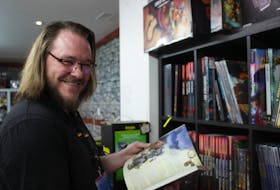
“The Promise” is Ida Linehan Young’s second novel of historical fictions (and third publication after her extraordinary memoir “No Turning Back: Surviving the Linehan Family Tragedy”). And “The Promise” is very much a sequel to her fiction debut of “Being Mary Ro.”
While the central character is new, she is surrounded by the cast of the former book, which is set in the same time period of late 19th Century Newfoundland.
It opens in 1894, North Harbour, at a funeral. Erith Lock, 24, is chief mourner at her step-mother’s wake. Not that mourning is a good descriptive of Erith’s feelings for Kathleen. The woman mistreated her as a child, sent her into service with relatives at the earliest opportunity (a decision with terrible consequences), and capped off her existence with a deathbed confession that Erith can’t decide is a truth or a taunt: “She’s alive, you know.” (“She” at this point still a mystery to the reader, but all will be revealed.).
Erith can’t remember her mother, Beatrice, but she can her father, Ben. Her parents emigrated from England and established a dry goods store and post office, but Ben returned to his calling of engineer, and the sea, after his wife died. In remarrying, he’d thought to provide a maternal caregiver to his only child, but his assessment of Kathleen’s nurturing instincts was off by a mile. Kathleen doesn’t want the girl underfoot, withholds vital financial information from her, and sends her to care for a widowed relative, left with three youngsters, when Erith is just sixteen and completely untrained in domestic arts.
Much worse, the men charged with conveying her safely to her new position attack her and leave her for dead. Erith’s force of will carries her through that predicament, and she does arrive in Dog Harbour, where George, Tommy, and Annie are waiting, with their father, Dinn. The new situation proves a haven of sorts, with the inhabitants of the tiny community happy to instruct a newcomer who can’t make bread or milk a cow. All hands are needed for the nonstop, backbreaking season of making the fish, although they also take time to play music, dance, and even swim. Soon Erith feels an unusual expression on her face, and a strange feeling inside: is this smiling? Is she happy?
But the assault on her has predicable effects, and Erith must return to Kathleen to have a baby, who is soon whisked away by Father Fleming, for adoption. Then Kathleen tells Erith that the priest met with an accident and he and the baby were lost. And Erith soon learns that Dinn has perished as well, leaving his children orphans. Before she left Dog Harbour, Erith had promised them she would come back to look after them. That is now her life’s goal.
Returning to 1894, Erith has reunited with the children (though exactly how is still a story to unfold) and is now introduced to a major figure from “Being Mary Ro”: Danol Cooper. The American-born former police officer triggered much of the action in that plot, and is now settling in North Harbour himself, captaining the “Angel Endeavours” and thinking of expanding into a broader shipping fleet. Cooper is a big man, and obviously of means, but it’s his detective background that has caught Erith’s attention. She might have a case for him. She sets out to converse with him, and much drama ensues.
Sometimes a little too much. There are fights and ambushes and more than one character left in a pool of blood. At the same time there can be a repetitive cycle to people’s emotions: Danol, for example, musing again and again over the exact shape and place for his feelings for Erith. At the same time some developments, such as one young child starting to speak, years after that milestone should have been marked, kind of fall by the wayside. And there’s some anachronistic language, including (admittedly a pet peeve) “surreal” used both decades before the term was coined, which was around the 1920s, and as a synonym for “unreal,” which it is not.)
But Linehan Young also (again) evokes a time and a place and a strong female lead. She has also well-positioned this book to pilot into a followup. Her knowledge of, and research into, the processes pre-20th century household labour, or the state of the justice system after the 1892 fire, pay off. Linehan Young has an unusual (I think) arc from memoir into historic fiction. But maybe it’s not — she’s all about her people, her place, and their collective memory.
Joan Sullivan is editor of Newfoundland Quarterly magazine. She reviews both fiction and non-fiction for The Telegram.
Previous column:
JOAN SULLIVAN: New books trace family ties and pastors’ lives









